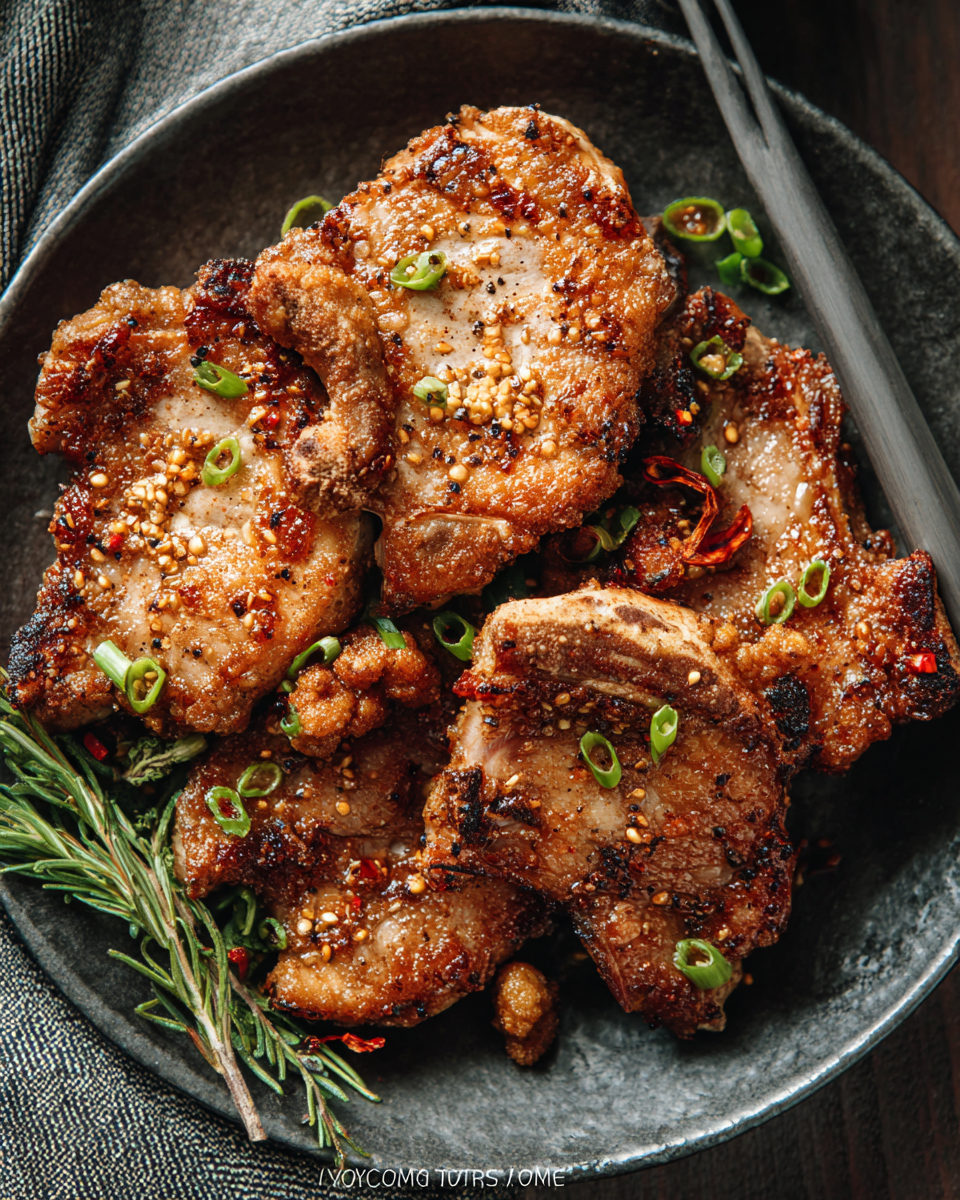Salt and Pepper Pork Chops are a staple of Chinese comfort cuisine—crispy, bold, and full of wok-fired aromatics. This recipe transforms simple pork chops into irresistible bites, coated in a golden crust and tossed with sizzling garlic, scallions, and chilies. It’s the kind of dish that steals the spotlight with minimal ingredients and maximum flavor. Perfect for weeknights or impressing dinner guests, this pork chop recipe is easy to prep and delivers restaurant-style results in under 40 minutes. Serve it alongside steamed jasmine rice or sautéed greens for a full meal that satisfies every craving for crispy, salty, spicy perfection.
Full recipe:
Ingredients:
-
4 boneless pork chops (about 1/2 inch thick)
-
1 tablespoon Shaoxing wine (or dry sherry)
-
1/2 teaspoon salt
-
1/2 teaspoon ground white pepper
-
2 cloves garlic, finely chopped
-
2 green onions, sliced
-
1–2 red chilies, thinly sliced (optional for heat)
-
1/2 cup cornstarch (or potato starch)
-
Oil for frying
Directions:
-
Pat pork chops dry and slice into bite-sized pieces.
-
In a bowl, combine pork with Shaoxing wine, salt, and white pepper. Let marinate for 15–20 minutes.
-
Heat oil in a wok or deep skillet over medium-high heat.
-
Coat marinated pork pieces evenly in cornstarch.
-
Fry pork in batches until golden brown and crispy, about 3–4 minutes per side. Remove and drain on paper towels.
-
In a clean pan or wok, use 1 tablespoon of oil to sauté garlic, green onions, and red chilies until fragrant, about 30 seconds.
-
Return crispy pork to the pan and toss quickly to coat in the aromatics.
-
Serve immediately with steamed rice or a fresh vegetable side.
Prep Time: 15 minutes | Cooking Time: 20 minutes | Total Time: 35 minutes
Kcal: 415 kcal | Servings: 4 servings
The History and Inspiration Behind Salt and Pepper Pork Chops
Salt and Pepper Pork Chops (椒盐猪排) are a beloved dish in Chinese and Cantonese cuisine, known for their bold flavors and crisp texture. Originating from Southern China, particularly the Guangdong region, the dish gained popularity in both Chinese households and restaurants for its simplicity and punchy taste. The salt and pepper seasoning mix—typically a blend of ground white pepper, salt, sometimes five-spice, and Sichuan peppercorn—was first used in seafood and fried appetizers. Over time, it was adapted to heartier proteins like pork and chicken, creating a savory staple that crosses culinary borders.
This recipe evolved with the Cantonese approach to quick wok-fried cooking: flash-frying the meat for a golden crisp crust, then tossing it with fried aromatics like garlic, chili, and scallions for irresistible aroma and flavor. What makes this dish universally loved is its minimal ingredient list paired with explosive flavor. It doesn’t rely on heavy sauces or marinades—instead, it lets technique and timing do the work.
Why Salt and Pepper Pork Chops Are a Must-Try
There’s something uniquely satisfying about the contrast of textures and bold simplicity in Salt and Pepper Pork Chops. The outside is crackling-crisp while the interior remains tender and juicy. Each bite bursts with savory seasoning, subtle heat, and aromatic depth from garlic and chilies. This dish isn’t just delicious—it’s crave-worthy.
What truly sets this recipe apart is how easy it is to replicate restaurant-quality results in your home kitchen. With a few pantry staples and a quick marination, you can whip up a dish that rivals your favorite takeout, but with better control over ingredients and customization. Whether you serve it as a main dish, party platter, or even sliced inside bao buns or wraps, it’s as versatile as it is delicious.
A Closer Look at the Ingredients
This dish keeps things simple, allowing the quality of each ingredient to shine. Pork chops provide the perfect protein base—lean yet flavorful, and ideal for quick cooking. Thinly sliced boneless pork is especially effective for even coating and crispy results.
Shaoxing wine, a fermented Chinese rice wine, enhances the natural meat flavor and adds umami depth. If unavailable, dry sherry is a decent substitute. White pepper is used instead of black for its distinctive, slightly musky flavor and cleaner heat. Garlic and green onions, sautéed quickly until fragrant, finish the dish with a punch of aroma and freshness. Red chilies are optional, but recommended if you enjoy a kick of heat.
Cornstarch or potato starch is used to coat the pork before frying. Unlike flour, starches create a lighter, crisper crust that stays crunchy even after tossing with aromatics. This is one of the reasons why Chinese fried dishes have that signature texture—delicate yet shatteringly crisp.
The Secret is in the Technique
While the ingredients are humble, the real success of this dish lies in the cooking technique. Marinating the pork for even just 15 minutes ensures that the seasoning penetrates while tenderizing the meat slightly. A light, even coating of cornstarch, followed by hot oil frying, creates the ideal texture.
One important tip: don’t overcrowd the pan. Fry the pork in batches if needed, which helps maintain high oil temperature and guarantees that crisp finish. After draining the pork, quickly stir-fry the aromatics in a small amount of oil to release their full fragrance, then toss the pork back in just long enough to combine everything without softening the coating.
This timing ensures that every bite is layered with crunch, spice, and warmth without becoming greasy or soggy.
Customizations and Variations
Salt and Pepper Pork Chops are endlessly adaptable. You can adjust the spice level by adding or reducing chilies. Want extra heat? Add some crushed Sichuan peppercorns for a tongue-tingling twist. Prefer it milder? Stick to garlic and scallions only.
This recipe also works beautifully with chicken thighs, tofu, shrimp, or even mushrooms for a vegetarian-friendly spin. For an extra savory finish, sprinkle with toasted sesame seeds or serve with a squeeze of lime to cut through the richness.
If you’re cooking for kids or spice-sensitive eaters, the seasoning can be toned down while still delivering big flavor. The crisp texture and savory notes are universally appealing, even without intense spice.
Nutritional Benefits and Balance
Despite being fried, this recipe can be part of a balanced meal when paired thoughtfully. Pork is a great source of lean protein, vitamins like B12 and zinc, and essential amino acids. By using a shallow fry method or air fryer, you can reduce excess oil without sacrificing texture.
Pairing these pork chops with steamed vegetables, bok choy, or jasmine rice helps round out the meal with fiber and nutrients. You can also opt for a low-sodium soy sauce drizzle or serve with a light vinegar-based dipping sauce for balance.
The minimal use of sugar or heavy sauces also makes this dish a healthier alternative to many other fried takeout options. You know exactly what’s going into the dish—and you can customize it to suit your dietary needs.
Perfect for Entertaining or Weeknight Meals
One of the biggest benefits of Salt and Pepper Pork Chops is how fast they are to prepare. From fridge to table in under 40 minutes, this dish is ideal for busy weeknights. Yet its punchy flavor and crispy presentation make it equally suitable for dinner parties, potlucks, or holiday feasts.
They also make an excellent appetizer for gatherings—just cut the pork into smaller bites and serve with toothpicks and dipping sauce. The crispness holds up well over time, especially if kept warm in the oven before serving.
Meal prepping? The pork can be marinated ahead of time and fried fresh when ready to eat. You can even prepare larger batches and reheat in an air fryer for next-day crispness.
How to Store and Reheat Leftovers
If you happen to have leftovers (which is rare!), they store beautifully. Place cooked pork chops in an airtight container in the refrigerator for up to 3 days. To reheat, the best method is in an air fryer or oven at 375°F (190°C) for about 5–7 minutes, which helps revive that crispy texture.
Avoid microwaving if possible—it tends to soften the crust and make the pork slightly rubbery. If using a pan, reheat with a tiny amount of oil and gently toss until warmed through.
You can also slice cold leftovers and add them to noodle bowls, fried rice, or wraps. The flavor is bold enough to carry over into new dishes, making it a smart option for using up leftovers creatively.
Why This Recipe Belongs in Every Home Cook’s Repertoire
There are certain recipes that check every box: easy, flavorful, satisfying, and versatile. Salt and Pepper Pork Chops are exactly that. Whether you’re looking to expand your Asian cooking skills, whip up a quick meal, or impress dinner guests without stress, this dish delivers. It also serves as a fantastic introduction to wok cooking and Chinese stir-fry methods, encouraging home cooks to explore new flavors without the intimidation of complex sauces or hard-to-find ingredients.This recipe is also budget-friendly. Pork chops are often more affordable than other meats, and the seasoning uses everyday pantry items. It’s high-impact flavor on a reasonable budget—and with easy-to-follow steps, anyone can master it.
Conclusion
Salt and Pepper Pork Chops are a shining example of how simple ingredients and great technique can create a stunning dish. Crisp on the outside, juicy on the inside, and packed with savory garlic and spice, these pork chops are a true celebration of Chinese-style comfort food. Quick enough for a weeknight dinner yet bold enough for guests, this dish deserves a spot in your regular recipe rotation. Try it once, and it might just become your new favorite way to enjoy pork.






